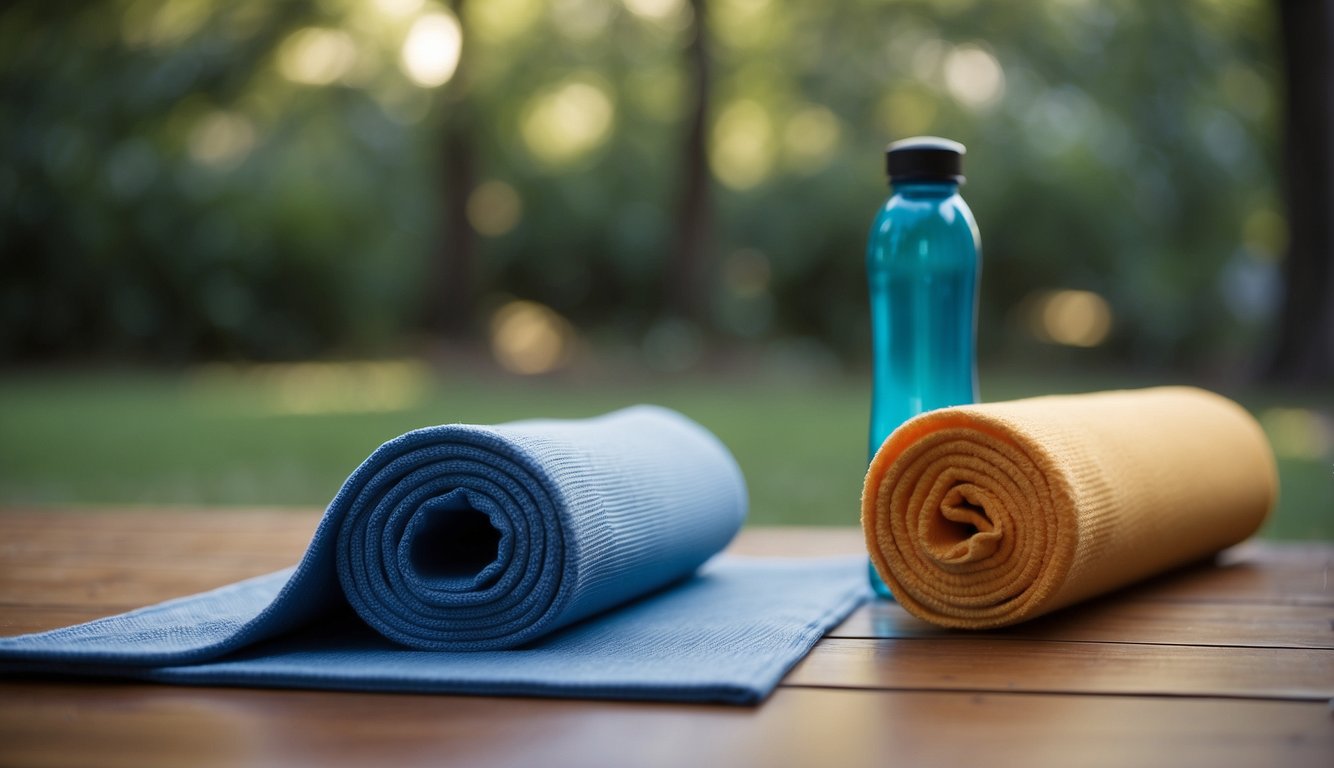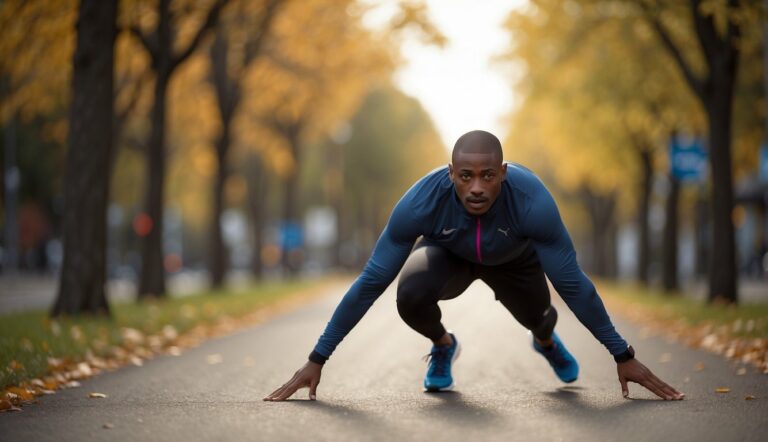Post-Run Stretches for Hip Flexibility: Enhancing Mobility & Recovery
Stretching after a run is crucial to maintain hip flexibility and prevent stiffness. As a UESCA certified running coach, I always emphasize the importance of post-run stretches to my runners. These stretches are designed to target the hips, which are pivotal for a runner’s performance and longevity in the sport. They help to alleviate tension from repetitive motions and enhance overall mobility.
My experience has taught me that hip flexibility can be significantly improved with a routine that includes specific stretches focusing on this area. Muscles surrounding the hips, such as the hip flexors, glutes, and lateral hip muscles, can become tight after running. Implementing a consistent stretching routine promotes flexibility and can lead to better running form and reduced risk of injury.
To optimize recovery and maintain a healthy range of motion, post-run stretches for the hips should be a non-negotiable part of every runner’s cooldown process. The stretches I recommend are not only effective but also easy to integrate into any fitness regimen. They can be done anywhere, require no equipment, and take just a few minutes to complete, making them a practical choice for runners of all levels.
Hip Flexibility and Running
Hip flexibility is a key factor in a runner’s performance, influencing both their stride and injury risk. Proper stretching can enhance range of motion and promote muscular balance.
The Role of Hip Flexibility in Running Performance
Hip Flexors:
The muscles that comprise the hip flexors are critical for stable, powerful running. They control leg lift during the swing phase of a running stride and play a substantial role in maintaining stride length and speed.
Range of Motion:
Enhanced hip flexibility allows for a greater range of motion, which can lead to a more efficient running gait. A full range of motion in the hips can help maintain proper alignment and reduce the energy cost of running.
Performance:
Tight hip flexors can lead to a shortened stride and may force other muscles to compensate, potentially leading to overuse injuries. Conversely, flexible hips can improve overall running mechanics, contributing to better performance outcomes.
Runners:
For runners specifically, hip flexibility should be a focus point for training regimes. It’s not just about stretching post-run, but also incorporating hip flexibility exercises into daily routines to support optimal running form and prevent injuries.
Essential Post-Run Stretches for Improved Flexibility
After a run, it’s crucial for me to dedicate time to stretching to prevent stiffness and enhance flexibility in my hips. These stretches target the muscles that are often the tightest after running.
Dynamic Stresses to Begin Recovery
Dynamic stretches are an excellent way to begin the recovery process immediately after a run. These movements enhance blood circulation and prepare the muscles for deeper stretches.
- Leg Swings: Stand upright, hold onto a stable object for balance, and swing one leg forward and backward. Perform 10-15 swings on each leg.
- Walking Lunges: Take a step forward with one leg, lower your hips until both knees are bent at a 90-degree angle. Step forward with the other leg and repeat. Complete ten lunges on each leg.
Static Stretches for Deep Muscle Relaxation
Static stretches come after dynamic stretches and involve holding a stretch position to relax and lengthen the muscles.
- Piriformis Stretch: Sit on the ground, with one leg straight out. Cross the other leg over, placing the foot flat on the ground, and gently lean forward. Hold the stretch for 30 seconds, then switch sides.
- Hip Flexor Stretch: Kneel on one knee with the other foot forward. Push your hips forward and hold for 30 seconds. Repeat on the other side.
Utilizing a combination of these dynamic and static stretches will aid in post-run muscle recovery and contribute to overall hip flexibility.
Targeting Key Muscle Groups

After a run, focusing on hip flexibility is vital to prevent stiffness and improve your range of motion. These stretches specifically target muscles that are often tight in runners, promoting recovery and flexibility.
Hamstring and Calf Focused Stretches
To ease tightness in the hamstrings and calves — muscles that bear significant impact during running — start with these stretches:
- Seated Hamstring Stretch
- Sit on the ground with both legs extended in front of you. Lean forward from your hips and reach toward your toes. Hold for 30 seconds to feel the stretch in your hamstrings.
- Standing Calf Stretch
- Face a wall and step one foot back. Keep your back heel grounded and lean forward until you feel a stretch in your calf. Maintain the stretch for 30 seconds then switch legs.
Stretches for Quads and Hip Flexors
Quadriceps and hip flexors are key drivers in running and need regular stretching:
-
- Stand on one leg and bring the heel of your other leg to your glute. Hold your foot or ankle and keep your knees together. Hold for 30 seconds then switch sides.
Lunging Hip Flexor Stretch
- Step forward into a lunge and drop your back knee to the floor. Push your hips forward to feel the stretch in the front of your hip. Hold for 30 seconds then switch sides.
Lower Back and Core Stretching Strategies
A strong and flexible lower back and core are critical for running posture and injury prevention:
- Knee-to-Chest Stretch
- Lie on your back and pull one knee into your chest while keeping the other leg straight. Hold for 30 seconds to stretch your lower back and switch legs.
- Bird-Dog
- On all fours, extend one arm and the opposite leg while keeping your core engaged. Hold for a few seconds then switch sides. This strengthens and stretches the core and lower back.
Upper Body Relaxation Techniques
Tension in the upper body can affect your running form, so it’s important to relax these muscles post-run:
- Shoulder Rolls
- Roll your shoulders slowly in a circular motion. This helps relieve tension in the shoulders and neck.
- Arm Cross Stretch
- Bring one arm across your body and gently press it towards you with the other arm. Hold for 30 seconds to stretch the shoulder, then switch arms.
Injury Prevention and Pain Management
Running, while an excellent form of cardiovascular exercise, often puts substantial strain on the hip muscles and can lead to common running injuries if proper care isn’t taken.
As a UESCA certified running coach, my approach focuses on careful stretching techniques and addressing muscle soreness to bolster injury prevention and manage pain effectively.
Stretching Techniques to Prevent Common Running Injuries
Injuries such as muscle strains and tendonitis can occur from consistent running. To prevent these, I incorporate specific stretching techniques post-run to maintain hip flexibility and reduce tension that leads to injury.
- Iliotibial (IT) Band Stretch: Essential for alleviating tension on the outside of the thigh and preventing IT band syndrome. After a run, cross the right leg behind the left and lean to the left, then switch sides.
- Psoas Stretch: Important for hip flexibility to prevent strains. Stand in a lunge position with the back knee on the ground, push the hips forward, and raise the arm of the back leg’s side above the head to stretch the front of the hip.
Addressing Muscle Soreness and Tightness
Muscle soreness and tightness post-run can lead to discomfort or pain. To manage these:
- Toe Touch Stretch: Stand with feet hip-width apart, bend forward at the hips, reach for the toes, and hold. This stretch helps target the hamstrings and lower back.
- Frog Hip Stretch: To ease muscle tightness in the hips and groin, perform the frog stretch. Kneel and widen the knees as much as comfortable, then lower yourself down to your forearms and hold the stretch.
By incorporating these stretching routines in your post-run recovery, you’re not only working towards preventing injuries but also promoting faster recovery and better performance. Remember, consistency is key in seeing the benefits of these stretches in terms of injury prevention and pain management.
Cooling Down and Recovery

After intense running, it’s crucial to focus on cooling down to enhance recovery and increase hip flexibility. By gradually reducing the intensity of the workout, you encourage your heart rate and breathing to return to resting levels in a controlled manner.
Breathing and Heart Rate Normalization
When beginning your cooldown, focus primarily on deep breathing. Deep, intentional breaths help decrease the heart rate and calm the body, shifting it from a state of exertion to one of recovery.
My routine includes inhaling for a count of five and exhaling for a count of five, gradually normalizing my breath and heart rate. This simple practice also promotes better blood flow, which is beneficial for reducing muscle stiffness.
Incorporating Mobility Tools
Using mobility tools like a foam roller can significantly aid in recovery post-run. These tools help massage and release muscle tension, especially in tight hip flexors.
I recommend spending a few minutes rolling out each major muscle group—quads, hamstrings, glutes, and calves—to aid in recovery. This not only improves blood flow to the muscles but also prevents the formation of knots and enhances overall hip flexibility.






